ASX Glossary - D: Difference between revisions
Jump to navigation
Jump to search
No edit summary |
No edit summary |
||
| Line 148: | Line 148: | ||
</head> | </head> | ||
<body> | <body> | ||
<table> | |||
<tr | <tr> | ||
<td class="term"> | |||
<a href="https://wiki.alsresume.com/index.php?title= | <a href="https://wiki.alsresume.com/index.php?title=Center_of_gravity_of_an_aircraft" target="_blank" | ||
style="color: #40E0D0; font-weight: bold; text-decoration: none; cursor: pointer;" | style="color: #40E0D0; font-weight: bold; text-decoration: none; cursor: pointer;" | ||
onmouseover="this.style.color='#ff4f01';" | onmouseover="this.style.color='#ff4f01';" | ||
onmouseout="this.style.color='#40E0D0';"> | onmouseout="this.style.color='#40E0D0';">Datum Line | ||
</a> | |||
</a | |||
</td> | </td> | ||
<td class="description">A reference line set by aircraft manufacturers for measuring distances and locations on an aircraft. It is used in weight and balance calculations to determine the center of gravity. The datum is typically an arbitrary point chosen by the manufacturer to maintain consistency in measurement across different aircraft designs.</td> | |||
<td class="image-column"><img src="https://www.alsresume.com/wp-content/uploads/2025/02/Datum.jpg" alt="Thumbnail"></td> | |||
</tr> | </tr> | ||
<tr | <tr> | ||
<td class="term"> | |||
<a href="https://wiki.alsresume.com/index.php?title= | <a href="https://wiki.alsresume.com/index.php?title=Dead_reckoning" target="_blank" | ||
style="color: #40E0D0; font-weight: bold; text-decoration: none; cursor: pointer;" | style="color: #40E0D0; font-weight: bold; text-decoration: none; cursor: pointer;" | ||
onmouseover="this.style.color='#ff4f01';" | onmouseover="this.style.color='#ff4f01';" | ||
onmouseout="this.style.color='#40E0D0';"> | onmouseout="this.style.color='#40E0D0';">Dead Reckoning | ||
</a> | </a> | ||
</td> | </td> | ||
<td class="description">A navigation technique where an aircraft’s position is estimated based on speed, time, and direction from a known position, rather than relying on external navigation aids. It is often used when GPS or radio navigation is unavailable. Pilots must account for wind drift and deviations to ensure accurate course tracking.</td> | |||
<td class="image-column"><img src="https://www.alsresume.com/wp-content/uploads/2025/02/Dead-Reconing.jpg" alt="Thumbnail"></td> | |||
</tr> | </tr> | ||
<tr | <tr> | ||
<td class="term"> | |||
<a href="https://wiki.alsresume.com/index.php?title= | <a href="https://wiki.alsresume.com/index.php?title=Deck_Angle" target="_blank" | ||
style="color: #40E0D0; font-weight: bold; text-decoration: none; cursor: pointer;" | style="color: #40E0D0; font-weight: bold; text-decoration: none; cursor: pointer;" | ||
onmouseover="this.style.color='#ff4f01';" | onmouseover="this.style.color='#ff4f01';" | ||
onmouseout="this.style.color='#40E0D0';"> | onmouseout="this.style.color='#40E0D0';">Deck Angle | ||
</a> | </a> | ||
</td> | </td> | ||
<td class="description">The angle between the aircraft's longitudinal axis and the horizontal plane. It is critical during takeoff, landing, and certain maneuvers. A high deck angle can indicate a nose-high attitude, while a low deck angle may suggest a nose-down flight condition, affecting aerodynamic stability and performance.</td> | |||
<td class="image-column"><img src="https://www.alsresume.com/wp-content/uploads/2025/02/Deck-Angle.jpg" alt="Thumbnail"></td> | |||
</tr> | </tr> | ||
<tr | <tr> | ||
<td class="term"> | |||
<a href="https://wiki.alsresume.com/index.php?title= | <a href="https://wiki.alsresume.com/index.php?title=Deicing_boot" target="_blank" | ||
style="color: #40E0D0; font-weight: bold; text-decoration: none; cursor: pointer;" | style="color: #40E0D0; font-weight: bold; text-decoration: none; cursor: pointer;" | ||
onmouseover="this.style.color='#ff4f01';" | onmouseover="this.style.color='#ff4f01';" | ||
onmouseout="this.style.color='#40E0D0';"> | onmouseout="this.style.color='#40E0D0';">Deicing Boots | ||
</a> | </a> | ||
</td> | </td> | ||
<td class="description">Rubber structures placed on the leading edges of wings and tail surfaces that expand and contract to break off accumulated ice. They are crucial for aircraft flying in icy conditions, preventing the buildup of ice that can disrupt airflow, reduce lift, and increase drag, leading to potential loss of control.</td> | |||
<td class="image-column"><img src="https://www.alsresume.com/wp-content/uploads/2025/02/Deicing-Boots.jpg" alt="Thumbnail"></td> | |||
</tr> | </tr> | ||
<tr | <tr> | ||
<td class="term"> | |||
<a href="https://wiki.alsresume.com/index.php?title= | <a href="https://wiki.alsresume.com/index.php?title=Density_Altitude" target="_blank" | ||
style="color: #40E0D0; font-weight: bold; text-decoration: none; cursor: pointer;" | style="color: #40E0D0; font-weight: bold; text-decoration: none; cursor: pointer;" | ||
onmouseover="this.style.color='#ff4f01';" | onmouseover="this.style.color='#ff4f01';" | ||
onmouseout="this.style.color='#40E0D0';"> | onmouseout="this.style.color='#40E0D0';">Density Altitude | ||
</a> | </a> | ||
</td> | </td> | ||
<td class="description">The pressure altitude corrected for temperature variations. It represents the altitude at which an aircraft “feels” it is flying based on air density. High-density altitude results in reduced engine power, propeller efficiency, and lift, making takeoff and climb performance significantly weaker in hot and high-altitude conditions.</td> | |||
<td class="image-column"><img src="https://www.alsresume.com/wp-content/uploads/2025/02/Density-Altitude.jpg" alt="Thumbnail"></td> | |||
</tr> | </tr> | ||
<tr | <tr> | ||
<td class="term"> | |||
<a href="https://wiki.alsresume.com/index.php?title= | <a href="https://wiki.alsresume.com/index.php?title=Standard_instrument_departure" target="_blank" | ||
style="color: #40E0D0; font-weight: bold; text-decoration: none; cursor: pointer;" | style="color: #40E0D0; font-weight: bold; text-decoration: none; cursor: pointer;" | ||
onmouseover="this.style.color='#ff4f01';" | onmouseover="this.style.color='#ff4f01';" | ||
onmouseout="this.style.color='#40E0D0';"> | onmouseout="this.style.color='#40E0D0';">Departure Procedure (DP) | ||
</a> | </a> | ||
</td> | </td> | ||
<td class="description">A standardized route for aircraft departing an airport, ensuring separation from obstacles and other air traffic. These procedures are either pilot-navigated or radar-vectored and help streamline departures, allowing for smooth transitions into en-route airspace while ensuring safe clearance from surrounding terrain.</td> | |||
<td class="image-column"><img src="https://www.alsresume.com/wp-content/uploads/2025/02/Departure.jpg" alt="Thumbnail"></td> | |||
</tr> | </tr> | ||
<tr | <tr> | ||
<td class="term"> | |||
<a href="https://wiki.alsresume.com/index.php?title= | <a href="https://wiki.alsresume.com/index.php?title=Dependent_Parallel_Approaches" target="_blank" | ||
style="color: #40E0D0; font-weight: bold; text-decoration: none; cursor: pointer;" | style="color: #40E0D0; font-weight: bold; text-decoration: none; cursor: pointer;" | ||
onmouseover="this.style.color='#ff4f01';" | onmouseover="this.style.color='#ff4f01';" | ||
onmouseout="this.style.color='#40E0D0';"> | onmouseout="this.style.color='#40E0D0';">Dependent Parallel Approaches | ||
</a> | </a> | ||
</td> | </td> | ||
<td class="description">A type of approach where two aircraft land simultaneously on parallel runways that are spaced close together. Air traffic controllers monitor and manage aircraft separation using strict sequencing. These approaches increase airport efficiency but require precise coordination and compliance with established separation minimums.</td> | |||
<td class="image-column"><img src="https://www.alsresume.com/wp-content/uploads/2025/02/Paralelle-Approach.jpg" alt="Thumbnail"></td> | |||
</tr> | </tr> | ||
<tr> | <tr> | ||
<td class="term"> | |||
<a href="https://wiki.alsresume.com/index.php?title= | <a href="https://wiki.alsresume.com/index.php?title=Uncontrolled_decompression" target="_blank" | ||
style="color: #40E0D0; font-weight: bold; text-decoration: none; cursor: pointer;" | style="color: #40E0D0; font-weight: bold; text-decoration: none; cursor: pointer;" | ||
onmouseover="this.style.color='#ff4f01';" | onmouseover="this.style.color='#ff4f01';" | ||
onmouseout="this.style.color='#40E0D0';"> | onmouseout="this.style.color='#40E0D0';">Depressurization | ||
</a> | </a> | ||
</td> | </td> | ||
<td class="description">A condition where cabin pressure is lost, potentially causing hypoxia for crew and passengers. It can occur due to structural failure, door seal issues, or rapid decompression. Pilots must respond immediately by donning oxygen masks, initiating an emergency descent, and following checklist procedures to ensure safety.</td> | |||
<td class="image-column"><img src="https://www.alsresume.com/wp-content/uploads/2025/02/Depressurization.jpg" alt="Thumbnail"></td> | |||
</tr> | </tr> | ||
<tr | <tr> | ||
<td class="term"> | |||
<a href="https://wiki.alsresume.com/index.php?title= | <a href="https://wiki.alsresume.com/index.php?title=Derated_Thrust" target="_blank" | ||
style="color: #40E0D0; font-weight: bold; text-decoration: none; cursor: pointer;" | style="color: #40E0D0; font-weight: bold; text-decoration: none; cursor: pointer;" | ||
onmouseover="this.style.color='#ff4f01';" | onmouseover="this.style.color='#ff4f01';" | ||
onmouseout="this.style.color='#40E0D0';"> | onmouseout="this.style.color='#40E0D0';">Derated Thrust | ||
</a> | </a> | ||
</td> | </td> | ||
<td class="description">A method where a jet engine operates below its maximum thrust capability to extend engine life and reduce wear. Airlines and operators use derated thrust settings to decrease fuel consumption, lower maintenance costs, and improve long-term performance without compromising flight safety.</td> | |||
<td class="image-column"><img src="https://www.alsresume.com/wp-content/uploads/2025/02/Derated.jpg" alt="Thumbnail"></td> | |||
</tr> | </tr> | ||
<tr | <tr> | ||
<td class="term"> | |||
<a href="https://wiki.alsresume.com/index.php?title= | <a href="https://wiki.alsresume.com/index.php?title=Continuous_descent_approach" target="_blank" | ||
style="color: #40E0D0; font-weight: bold; text-decoration: none; cursor: pointer;" | style="color: #40E0D0; font-weight: bold; text-decoration: none; cursor: pointer;" | ||
onmouseover="this.style.color='#ff4f01';" | onmouseover="this.style.color='#ff4f01';" | ||
onmouseout="this.style.color='#40E0D0';"> | onmouseout="this.style.color='#40E0D0';">Descent Profile | ||
</a> | </a> | ||
</td> | </td> | ||
<td class="description">A predetermined vertical flight path that an aircraft follows when descending from cruising altitude to landing. It ensures a controlled and efficient descent while maintaining fuel efficiency and compliance with air traffic control clearances. The profile considers terrain, weather, and airport approach procedures.</td> | |||
<td class="image-column"><img src="https://www.alsresume.com/wp-content/uploads/2025/02/Decent-Profile.jpg" alt="Thumbnail"></td> | |||
</tr> | </tr> | ||
<tr | <tr> | ||
<td class="term"> | |||
<a href="https://wiki.alsresume.com/index.php?title= | <a href="https://wiki.alsresume.com/index.php?title=Engine_knocking" target="_blank" | ||
style="color: #40E0D0; font-weight: bold; text-decoration: none; cursor: pointer;" | style="color: #40E0D0; font-weight: bold; text-decoration: none; cursor: pointer;" | ||
onmouseover="this.style.color='#ff4f01';" | onmouseover="this.style.color='#ff4f01';" | ||
onmouseout="this.style.color='#40E0D0';"> | onmouseout="this.style.color='#40E0D0';">Detonation | ||
</a> | </a> | ||
</td> | </td> | ||
<td class="description">An abnormal and uncontrolled combustion event in a piston engine where fuel-air mixture ignites prematurely. This results in extreme temperature and pressure spikes, which can cause engine damage, knocking sounds, and reduced efficiency. Pilots prevent detonation by using correct fuel grades and operating within safe engine parameters.</td> | |||
<td class="image-column"><img src="https://www.alsresume.com/wp-content/uploads/2025/02/Detonation.jpg" alt="Thumbnail"></td> | |||
</tr> | </tr> | ||
<tr | <tr> | ||
<td class="term"> | |||
<a href="https://wiki.alsresume.com/index.php?title= | <a href="https://wiki.alsresume.com/index.php?title=Dihedral_angle" target="_blank" | ||
style="color: #40E0D0; font-weight: bold; text-decoration: none; cursor: pointer;" | style="color: #40E0D0; font-weight: bold; text-decoration: none; cursor: pointer;" | ||
onmouseover="this.style.color='#ff4f01';" | onmouseover="this.style.color='#ff4f01';" | ||
onmouseout="this.style.color='#40E0D0';"> | onmouseout="this.style.color='#40E0D0';">Dihedral Angle | ||
</a> | </a> | ||
</td> | </td> | ||
<td class="description">The upward angle of an aircraft’s wings relative to the horizontal plane. It contributes to lateral stability, helping an aircraft return to level flight after a roll disturbance. Commercial aircraft typically have positive dihedral angles to improve passenger comfort by reducing roll oscillations in turbulent conditions.</td> | |||
<td class="image-column"><img src="https://www.alsresume.com/wp-content/uploads/2025/02/Dihedral.jpg" alt="Thumbnail"></td> | |||
</tr> | </tr> | ||
<tr | <tr> | ||
<td class="term"> | |||
<a href="https:// | <a href="https://wiki.alsresume.com/index.php?title=Landing_gear#Differential_braking" target="_blank" | ||
style="color: #40E0D0; font-weight: bold; text-decoration: none; cursor: pointer;" | style="color: #40E0D0; font-weight: bold; text-decoration: none; cursor: pointer;" | ||
onmouseover="this.style.color='#ff4f01';" | onmouseover="this.style.color='#ff4f01';" | ||
onmouseout="this.style.color='#40E0D0';"> | onmouseout="this.style.color='#40E0D0';">Differential Braking | ||
</a> | </a> | ||
</td> | </td> | ||
<td class="description">A technique where the pilot applies brake pressure to one wheel more than the other to assist in turning the aircraft while taxiing. This is especially useful for maneuvering in tight spaces, when steering limitations exist, or when using tailwheel aircraft that lack nosewheel steering.</td> | |||
<td class="image-column"><img src="https://www.alsresume.com/wp-content/uploads/2025/02/Differential-Breaking.jpg" alt="Thumbnail"></td> | |||
</tr> | </tr> | ||
<tr | <tr> | ||
<td class="term"> | |||
<a href="https://wiki.alsresume.com/index.php?title= | <a href="https://wiki.alsresume.com/index.php?title=(DCT)_Direct" target="_blank" | ||
style="color: #40E0D0; font-weight: bold; text-decoration: none; cursor: pointer;" | style="color: #40E0D0; font-weight: bold; text-decoration: none; cursor: pointer;" | ||
onmouseover="this.style.color='#ff4f01';" | onmouseover="this.style.color='#ff4f01';" | ||
onmouseout="this.style.color='#40E0D0';"> | onmouseout="this.style.color='#40E0D0';">Direct To (DCT) | ||
</a> | </a> | ||
</td> | </td> | ||
<td class="description">A function in flight management systems allowing pilots to fly directly to a selected waypoint, bypassing intervening waypoints or airways. It simplifies navigation, reduces fuel consumption, and shortens flight time, commonly used when air traffic control grants permission for more efficient routing.</td> | |||
<td class="image-column"><img src="https://www.alsresume.com/wp-content/uploads/2025/02/Direct.jpg" alt="Thumbnail"></td> | |||
</tr> | </tr> | ||
<tr | <tr> | ||
<td class="term"> | |||
<a href="https://wiki.alsresume.com/index.php?title= | <a href="https://wiki.alsresume.com/index.php?title=Rudder#Aircraft_rudders" target="_blank" | ||
style="color: #40E0D0; font-weight: bold; text-decoration: none; cursor: pointer;" | style="color: #40E0D0; font-weight: bold; text-decoration: none; cursor: pointer;" | ||
onmouseover="this.style.color='#ff4f01';" | onmouseover="this.style.color='#ff4f01';" | ||
onmouseout="this.style.color='#40E0D0';"> | onmouseout="this.style.color='#40E0D0';">Directional Control | ||
</a> | </a> | ||
</td> | </td> | ||
<td class="description">An aircraft’s ability to maintain its intended heading using aerodynamic control surfaces such as the rudder. It is crucial during takeoff, landing, and crosswind operations. Loss of directional control can lead to runway excursions or instability in flight, requiring immediate corrective actions.</td> | |||
<td class="image-column"><img src="https://www.alsresume.com/wp-content/uploads/2025/02/Directional.jpg" alt="Thumbnail"></td> | |||
</tr> | </tr> | ||
<tr | <tr> | ||
<td class="term"> | |||
<a href="https://wiki.alsresume.com/index.php?title= | <a href="https://wiki.alsresume.com/index.php?title=Water_landing#Airplane_water_ditchings" target="_blank" | ||
style="color: #40E0D0; font-weight: bold; text-decoration: none; cursor: pointer;" | style="color: #40E0D0; font-weight: bold; text-decoration: none; cursor: pointer;" | ||
onmouseover="this.style.color='#ff4f01';" | onmouseover="this.style.color='#ff4f01';" | ||
onmouseout="this.style.color='#40E0D0';"> | onmouseout="this.style.color='#40E0D0';">Ditching | ||
</a> | </a> | ||
</td> | </td> | ||
<td class="description">An emergency landing performed on water when returning to land is not possible. Pilots follow specific ditching procedures, including reducing speed, configuring the aircraft for a water landing, and preparing passengers for evacuation. Life rafts, flotation devices, and emergency locator beacons are critical for survival.</td> | |||
<td class="image-column"><img src="https://www.alsresume.com/wp-content/uploads/2025/02/Ditching.jpg" alt="Thumbnail"></td> | |||
</tr> | </tr> | ||
<tr | <tr> | ||
<td class="term"> | |||
<a href="https://wiki.alsresume.com/index.php?title= | <a href="https://wiki.alsresume.com/index.php?title=Doppler_radar" target="_blank" | ||
style="color: #40E0D0; font-weight: bold; text-decoration: none; cursor: pointer;" | style="color: #40E0D0; font-weight: bold; text-decoration: none; cursor: pointer;" | ||
onmouseover="this.style.color='#ff4f01';" | onmouseover="this.style.color='#ff4f01';" | ||
onmouseout="this.style.color='#40E0D0';"> | onmouseout="this.style.color='#40E0D0';">Doppler Rada | ||
</a> | </a> | ||
</td> | </td> | ||
<td class="description">A radar system used to detect weather conditions, aircraft velocity, and wind shear. It operates by measuring frequency shifts in radar waves reflected off moving objects. It is widely used in aviation for predicting turbulence, monitoring precipitation, and improving situational awareness in adverse weather conditions.</td> | |||
<td class="image-column"><img src="https://www.alsresume.com/wp-content/uploads/2025/02/Doppler.jpg" alt="Thumbnail"></td> | |||
</tr> | </tr> | ||
<tr | <tr> | ||
<td class="term"> | |||
<a href="https://wiki.alsresume.com/index.php?title= | <a href="https://wiki.alsresume.com/index.php?title=Downburst" target="_blank" | ||
style="color: #40E0D0; font-weight: bold; text-decoration: none; cursor: pointer;" | style="color: #40E0D0; font-weight: bold; text-decoration: none; cursor: pointer;" | ||
onmouseover="this.style.color='#ff4f01';" | onmouseover="this.style.color='#ff4f01';" | ||
onmouseout="this.style.color='#40E0D0';"> | onmouseout="this.style.color='#40E0D0';">Downburst | ||
</a> | </a> | ||
</td> | </td> | ||
<td class="description">A powerful, localized downdraft of air that can create hazardous wind conditions near the ground. Downbursts can produce intense wind shear, posing a severe threat to aircraft on approach or departure. Pilots use onboard wind shear detection systems and ground-based radar to mitigate these risks.</td> | |||
<td class="image-column"><img src="https://www.alsresume.com/wp-content/uploads/2025/02/Downburst.jpg" alt="Thumbnail"></td> | |||
</tr> | </tr> | ||
<tr | <tr> | ||
<td class="term"> | |||
<a href="https://wiki.alsresume.com/index.php?title= | <a href="https://wiki.alsresume.com/index.php?title=Downwash" target="_blank" | ||
style="color: #40E0D0; font-weight: bold; text-decoration: none; cursor: pointer;" | style="color: #40E0D0; font-weight: bold; text-decoration: none; cursor: pointer;" | ||
onmouseover="this.style.color='#ff4f01';" | onmouseover="this.style.color='#ff4f01';" | ||
onmouseout="this.style.color='#40E0D0';"> | onmouseout="this.style.color='#40E0D0';">Downwash | ||
</a> | </a> | ||
</td> | </td> | ||
<td class="description">The downward flow of air produced by a wing or rotor. It is a byproduct of lift generation and plays a crucial role in aerodynamics. Helicopters experience strong downwash, which can impact ground personnel and affect aircraft flying in close formation.</td> | |||
<td class="image-column"><img src="https://www.alsresume.com/wp-content/uploads/2025/02/Downwash.jpg" alt="Thumbnail"></td> | |||
</tr> | </tr> | ||
<tr | <tr> | ||
<td class="term"> | |||
<a href="https://wiki.alsresume.com/index.php?title=Airfield_traffic_pattern" target="_blank" | |||
<a href="https://wiki.alsresume.com/index.php?title= | |||
style="color: #40E0D0; font-weight: bold; text-decoration: none; cursor: pointer;" | style="color: #40E0D0; font-weight: bold; text-decoration: none; cursor: pointer;" | ||
onmouseover="this.style.color='#ff4f01';" | onmouseover="this.style.color='#ff4f01';" | ||
onmouseout="this.style.color='#40E0D0';"> | onmouseout="this.style.color='#40E0D0';">Downwind Leg | ||
</a> | </a> | ||
</td> | </td> | ||
<td class="description">A segment of the traffic pattern flown parallel to the landing runway but in the opposite direction of landing. It allows pilots to sequence their approach before turning onto the base and final legs. Proper coordination with air traffic control ensures smooth and safe integration into the traffic flow.</td> | |||
<td class="image-column"><img src="https://www.alsresume.com/wp-content/uploads/2025/02/Downwind-Leg.jpg" alt="Thumbnail"></td> | |||
</tr> | </tr> | ||
<tr | <tr> | ||
<td class="term"> | |||
<a href="https://wiki.alsresume.com/index.php?title= | <a href="https://wiki.alsresume.com/index.php?title=Drag_(physics)" target="_blank" | ||
style="color: #40E0D0; font-weight: bold; text-decoration: none; cursor: pointer;" | style="color: #40E0D0; font-weight: bold; text-decoration: none; cursor: pointer;" | ||
onmouseover="this.style.color='#ff4f01';" | onmouseover="this.style.color='#ff4f01';" | ||
onmouseout="this.style.color='#40E0D0';"> | onmouseout="this.style.color='#40E0D0';">Drag | ||
</a> | </a> | ||
</td> | </td> | ||
<td class="description">An aerodynamic force that opposes an aircraft’s forward motion. It consists of parasite drag (caused by non-lifting components) and induced drag (generated by lift). Reducing drag improves fuel efficiency, increases speed, and enhances overall aircraft performance.</td> | |||
<td class="image-column"><img src="https://www.alsresume.com/wp-content/uploads/2025/02/Drag.jpg" alt="Thumbnail"></td> | |||
</tr> | </tr> | ||
<tr | <tr> | ||
<td class="term"> | |||
<a href="https://wiki.alsresume.com/index.php?title= | <a href="https://wiki.alsresume.com/index.php?title=Drag_coefficient" target="_blank" | ||
style="color: #40E0D0; font-weight: bold; text-decoration: none; cursor: pointer;" | style="color: #40E0D0; font-weight: bold; text-decoration: none; cursor: pointer;" | ||
onmouseover="this.style.color='#ff4f01';" | onmouseover="this.style.color='#ff4f01';" | ||
onmouseout="this.style.color='#40E0D0';"> | onmouseout="this.style.color='#40E0D0';">Drag Coefficient | ||
</a> | </a> | ||
</td> | </td> | ||
<td class="description">A numerical value that quantifies an aircraft’s aerodynamic efficiency by measuring the amount of drag it produces. Lower drag coefficients indicate more streamlined designs, reducing fuel consumption and improving performance. Engineers optimize airframes to minimize drag while maintaining structural integrity. | |||
</td> | |||
<td class="image-column"><img src="https://www.alsresume.com/wp-content/uploads/2025/02/Drag-Co.jpg" alt="Thumbnail"></td> | |||
</tr> | </tr> | ||
<tr> | |||
<td class="term"> | |||
<a href="https://wiki.alsresume.com/index.php?title= | <a href="https://wiki.alsresume.com/index.php?title=Formation_flying#Mechanism_of_drag_reduction" target="_blank" | ||
style="color: #40E0D0; font-weight: bold; text-decoration: none; cursor: pointer;" | style="color: #40E0D0; font-weight: bold; text-decoration: none; cursor: pointer;" | ||
onmouseover="this.style.color='#ff4f01';" | onmouseover="this.style.color='#ff4f01';" | ||
onmouseout="this.style.color='#40E0D0';"> | onmouseout="this.style.color='#40E0D0';">Drag Reduction | ||
</a> | </a> | ||
</td> | </td> | ||
<td class="description">Techniques used to minimize aerodynamic resistance. Methods include laminar flow control, winglets, and retractable landing gear. Aircraft designers continuously improve drag reduction strategies to enhance range, fuel economy, and speed while maintaining safety and stability.</td> | |||
<td class="image-column"><img src="https://www.alsresume.com/wp-content/uploads/2025/02/Drag-Reduction.jpg" alt="Thumbnail"></td> | |||
</tr> | </tr> | ||
<tr | <tr> | ||
<td class="term"> | |||
<a href=" | <a href="hhttps://wiki.alsresume.com/index.php?title=Drain_Mast" target="_blank" | ||
style="color: #40E0D0; font-weight: bold; text-decoration: none; cursor: pointer;" | style="color: #40E0D0; font-weight: bold; text-decoration: none; cursor: pointer;" | ||
onmouseover="this.style.color='#ff4f01';" | onmouseover="this.style.color='#ff4f01';" | ||
onmouseout="this.style.color='#40E0D0';"> | onmouseout="this.style.color='#40E0D0';">Drain Mast | ||
</a> | </a> | ||
</td> | </td> | ||
<td class="description">A small external component used to expel excess fluids such as condensation, fuel residue, or waste from onboard systems. Proper drainage prevents corrosion, icing, and damage to critical components, ensuring aircraft integrity and performance over long-term operation.</td> | |||
<td class="image-column"><img src="https://www.alsresume.com/wp-content/uploads/2025/02/Drain-Mast.jpg" alt="Thumbnail"></td> | |||
</tr> | </tr> | ||
<tr | <tr> | ||
<td class="term"> | |||
<a href="https://wiki.alsresume.com/index.php?title= | <a href="https://wiki.alsresume.com/index.php?title=Drift_Angle" target="_blank" | ||
style="color: #40E0D0; font-weight: bold; text-decoration: none; cursor: pointer;" | style="color: #40E0D0; font-weight: bold; text-decoration: none; cursor: pointer;" | ||
onmouseover="this.style.color='#ff4f01';" | onmouseover="this.style.color='#ff4f01';" | ||
onmouseout="this.style.color='#40E0D0';"> | onmouseout="this.style.color='#40E0D0';">Drift Angle | ||
</a> | </a> | ||
</td> | </td> | ||
<td class="description">The angle between an aircraft’s heading and its actual ground track caused by wind. Pilots compensate for drift using wind correction angles to maintain the intended flight path, ensuring accurate navigation, especially when flying cross-country or conducting precision approaches.</td> | |||
<td class="image-column"><img src="https://www.alsresume.com/wp-content/uploads/2025/02/Drift-Angle.jpg" alt="Thumbnail"></td> | |||
</tr> | </tr> | ||
<tr | <tr> | ||
<td class="term"> | |||
<a href="https://wiki.alsresume.com/index.php?title= | <a href="https://wiki.alsresume.com/index.php?title=Drift_Down" target="_blank" | ||
style="color: #40E0D0; font-weight: bold; text-decoration: none; cursor: pointer;" | style="color: #40E0D0; font-weight: bold; text-decoration: none; cursor: pointer;" | ||
onmouseover="this.style.color='#ff4f01';" | onmouseover="this.style.color='#ff4f01';" | ||
onmouseout="this.style.color='#40E0D0';"> | onmouseout="this.style.color='#40E0D0';">Drift Down | ||
</a> | </a> | ||
</td> | </td> | ||
<td class="description">A procedure followed when an engine failure occurs at cruising altitude. The aircraft descends to an altitude where it can maintain level flight on the remaining engine(s). Pilots use drift-down charts to determine optimal altitudes for safety and fuel efficiency.</td> | |||
<td class="image-column"><img src="https://www.alsresume.com/wp-content/uploads/2025/02/Drift-Down.jpg" alt="Thumbnail"></td> | |||
</tr> | </tr> | ||
<tr | <tr> | ||
<td class="term"> | |||
<a href="https://wiki.alsresume.com/index.php?title= | <a href="https://wiki.alsresume.com/index.php?title=Drop_tank" target="_blank" | ||
style="color: #40E0D0; font-weight: bold; text-decoration: none; cursor: pointer;" | style="color: #40E0D0; font-weight: bold; text-decoration: none; cursor: pointer;" | ||
onmouseover="this.style.color='#ff4f01';" | onmouseover="this.style.color='#ff4f01';" | ||
onmouseout="this.style.color='#40E0D0';"> | onmouseout="this.style.color='#40E0D0';">Drop Tank | ||
</a> | </a> | ||
</td> | </td> | ||
<td class="description">An external fuel tank mounted on military or long-range aircraft to extend operational range. Drop tanks can be jettisoned in emergencies to reduce weight and improve maneuverability. They play a vital role in ferry flights, combat missions, and long-duration operations.</td> | |||
<td class="image-column"><img src="https://www.alsresume.com/wp-content/uploads/2025/02/Drop-Tank.jpg" alt="Thumbnail"></td> | |||
</tr> | </tr> | ||
<tr | <tr> | ||
<td class="term"> | |||
<a href="https://wiki.alsresume.com/index.php?title= | <a href="https://wiki.alsresume.com/index.php?title=Aircraft_lease#Dry_lease" target="_blank" | ||
style="color: #40E0D0; font-weight: bold; text-decoration: none; cursor: pointer;" | style="color: #40E0D0; font-weight: bold; text-decoration: none; cursor: pointer;" | ||
onmouseover="this.style.color='#ff4f01';" | onmouseover="this.style.color='#ff4f01';" | ||
onmouseout="this.style.color='#40E0D0';"> | onmouseout="this.style.color='#40E0D0';">Dry Lease | ||
</a> | </a> | ||
</td> | </td> | ||
<td class="description">A leasing arrangement where an aircraft is provided without crew, maintenance, or insurance. The lessee is responsible for all operational aspects. Dry leases are commonly used by airlines expanding their fleets without purchasing new aircraft outright.</td> | |||
<td class="image-column"><img src="https://www.alsresume.com/wp-content/uploads/2025/02/Dry-Lease.jpg" alt="Thumbnail"></td> | |||
</tr> | </tr> | ||
<tr | <tr> | ||
<td class="term"> | |||
<a href="https://wiki.alsresume.com/index.php?title= | <a href="https://wiki.alsresume.com/index.php?title=Dutch_roll" target="_blank" | ||
style="color: #40E0D0; font-weight: bold; text-decoration: none; cursor: pointer;" | style="color: #40E0D0; font-weight: bold; text-decoration: none; cursor: pointer;" | ||
onmouseover="this.style.color='#ff4f01';" | onmouseover="this.style.color='#ff4f01';" | ||
onmouseout="this.style.color='#40E0D0';"> | onmouseout="this.style.color='#40E0D0';">Dutch Roll | ||
</a> | </a> | ||
</td> | </td> | ||
<td class="description">A flight instability characterized by coupled yaw and roll oscillations. It is most commonly experienced in swept-wing aircraft. Pilots use yaw dampers to counteract Dutch roll, improving comfort and stability during cruise.</td> | |||
<td class="image-column"><img src="https://www.alsresume.com/wp-content/uploads/2025/02/Dutch-Roll.jpg" alt="Thumbnail"></td> | |||
</tr> | </tr> | ||
<tr | <tr> | ||
<td class="term"> | |||
<a href="https://wiki.alsresume.com/index.php?title= | <a href="https://wiki.alsresume.com/index.php?title=Aircraft_flight_dynamics#Stability" target="_blank" | ||
style="color: #40E0D0; font-weight: bold; text-decoration: none; cursor: pointer;" | style="color: #40E0D0; font-weight: bold; text-decoration: none; cursor: pointer;" | ||
onmouseover="this.style.color='#ff4f01';" | onmouseover="this.style.color='#ff4f01';" | ||
onmouseout="this.style.color='#40E0D0';"> | onmouseout="this.style.color='#40E0D0';">Dynamic Stability | ||
</a> | </a> | ||
</td> | </td> | ||
<td class="description">An aircraft’s tendency to return to its original flight condition after a disturbance. It ensures stability over time and helps the aircraft remain controllable in varying flight conditions, minimizing pilot workload and enhancing safety.</td> | |||
<td class="image-column"><img src="https://www.alsresume.com/wp-content/uploads/2025/02/Dynamic-Stability.jpg" alt="Thumbnail"></td> | |||
</tr> | </tr> | ||
</table> | |||
</body> | </body> | ||
</html> | </html> | ||
Latest revision as of 18:54, 23 April 2025

| Click on term for full definition | Click here to report corrections and content addition requests |
| Datum Line | A reference line set by aircraft manufacturers for measuring distances and locations on an aircraft. It is used in weight and balance calculations to determine the center of gravity. The datum is typically an arbitrary point chosen by the manufacturer to maintain consistency in measurement across different aircraft designs. | 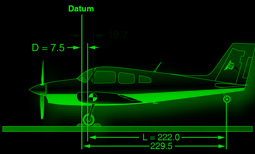 |
| Dead Reckoning | A navigation technique where an aircraft’s position is estimated based on speed, time, and direction from a known position, rather than relying on external navigation aids. It is often used when GPS or radio navigation is unavailable. Pilots must account for wind drift and deviations to ensure accurate course tracking. | 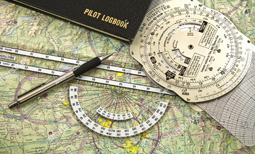 |
| Deck Angle | The angle between the aircraft's longitudinal axis and the horizontal plane. It is critical during takeoff, landing, and certain maneuvers. A high deck angle can indicate a nose-high attitude, while a low deck angle may suggest a nose-down flight condition, affecting aerodynamic stability and performance. | 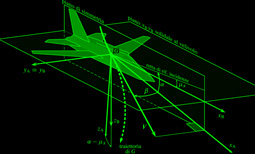 |
| Deicing Boots | Rubber structures placed on the leading edges of wings and tail surfaces that expand and contract to break off accumulated ice. They are crucial for aircraft flying in icy conditions, preventing the buildup of ice that can disrupt airflow, reduce lift, and increase drag, leading to potential loss of control. | 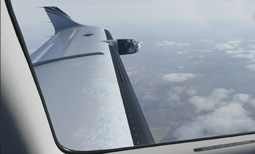 |
| Density Altitude | The pressure altitude corrected for temperature variations. It represents the altitude at which an aircraft “feels” it is flying based on air density. High-density altitude results in reduced engine power, propeller efficiency, and lift, making takeoff and climb performance significantly weaker in hot and high-altitude conditions. | 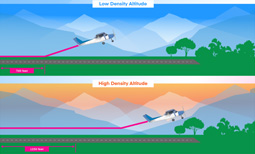 |
| Departure Procedure (DP) | A standardized route for aircraft departing an airport, ensuring separation from obstacles and other air traffic. These procedures are either pilot-navigated or radar-vectored and help streamline departures, allowing for smooth transitions into en-route airspace while ensuring safe clearance from surrounding terrain. | 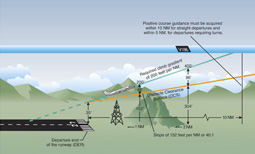 |
| Dependent Parallel Approaches | A type of approach where two aircraft land simultaneously on parallel runways that are spaced close together. Air traffic controllers monitor and manage aircraft separation using strict sequencing. These approaches increase airport efficiency but require precise coordination and compliance with established separation minimums. | 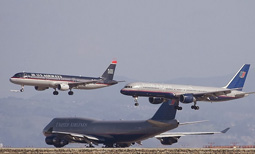 |
| Depressurization | A condition where cabin pressure is lost, potentially causing hypoxia for crew and passengers. It can occur due to structural failure, door seal issues, or rapid decompression. Pilots must respond immediately by donning oxygen masks, initiating an emergency descent, and following checklist procedures to ensure safety. | 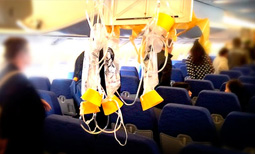 |
| Derated Thrust | A method where a jet engine operates below its maximum thrust capability to extend engine life and reduce wear. Airlines and operators use derated thrust settings to decrease fuel consumption, lower maintenance costs, and improve long-term performance without compromising flight safety. | 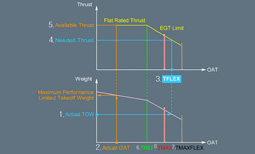 |
| Descent Profile | A predetermined vertical flight path that an aircraft follows when descending from cruising altitude to landing. It ensures a controlled and efficient descent while maintaining fuel efficiency and compliance with air traffic control clearances. The profile considers terrain, weather, and airport approach procedures. | 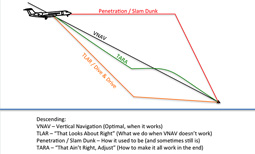 |
| Detonation | An abnormal and uncontrolled combustion event in a piston engine where fuel-air mixture ignites prematurely. This results in extreme temperature and pressure spikes, which can cause engine damage, knocking sounds, and reduced efficiency. Pilots prevent detonation by using correct fuel grades and operating within safe engine parameters. | 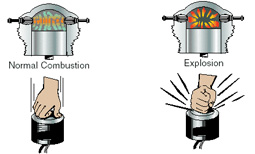 |
| Dihedral Angle | The upward angle of an aircraft’s wings relative to the horizontal plane. It contributes to lateral stability, helping an aircraft return to level flight after a roll disturbance. Commercial aircraft typically have positive dihedral angles to improve passenger comfort by reducing roll oscillations in turbulent conditions. | 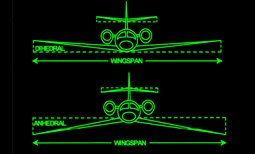 |
| Differential Braking | A technique where the pilot applies brake pressure to one wheel more than the other to assist in turning the aircraft while taxiing. This is especially useful for maneuvering in tight spaces, when steering limitations exist, or when using tailwheel aircraft that lack nosewheel steering. | 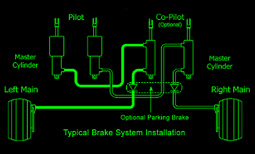 |
| Direct To (DCT) | A function in flight management systems allowing pilots to fly directly to a selected waypoint, bypassing intervening waypoints or airways. It simplifies navigation, reduces fuel consumption, and shortens flight time, commonly used when air traffic control grants permission for more efficient routing. | 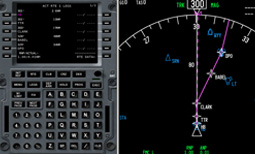 |
| Directional Control | An aircraft’s ability to maintain its intended heading using aerodynamic control surfaces such as the rudder. It is crucial during takeoff, landing, and crosswind operations. Loss of directional control can lead to runway excursions or instability in flight, requiring immediate corrective actions. | 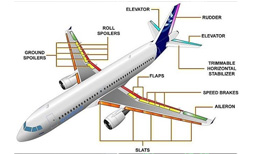 |
| Ditching | An emergency landing performed on water when returning to land is not possible. Pilots follow specific ditching procedures, including reducing speed, configuring the aircraft for a water landing, and preparing passengers for evacuation. Life rafts, flotation devices, and emergency locator beacons are critical for survival. | 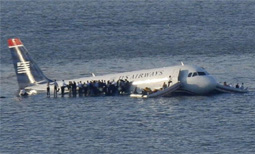 |
| Doppler Rada | A radar system used to detect weather conditions, aircraft velocity, and wind shear. It operates by measuring frequency shifts in radar waves reflected off moving objects. It is widely used in aviation for predicting turbulence, monitoring precipitation, and improving situational awareness in adverse weather conditions. | 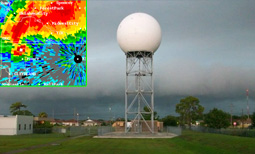 |
| Downburst | A powerful, localized downdraft of air that can create hazardous wind conditions near the ground. Downbursts can produce intense wind shear, posing a severe threat to aircraft on approach or departure. Pilots use onboard wind shear detection systems and ground-based radar to mitigate these risks. |  |
| Downwash | The downward flow of air produced by a wing or rotor. It is a byproduct of lift generation and plays a crucial role in aerodynamics. Helicopters experience strong downwash, which can impact ground personnel and affect aircraft flying in close formation. |  |
| Downwind Leg | A segment of the traffic pattern flown parallel to the landing runway but in the opposite direction of landing. It allows pilots to sequence their approach before turning onto the base and final legs. Proper coordination with air traffic control ensures smooth and safe integration into the traffic flow. | 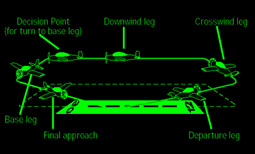 |
| Drag | An aerodynamic force that opposes an aircraft’s forward motion. It consists of parasite drag (caused by non-lifting components) and induced drag (generated by lift). Reducing drag improves fuel efficiency, increases speed, and enhances overall aircraft performance. | 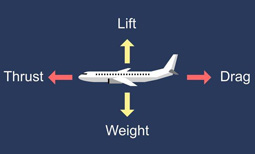 |
| Drag Coefficient | A numerical value that quantifies an aircraft’s aerodynamic efficiency by measuring the amount of drag it produces. Lower drag coefficients indicate more streamlined designs, reducing fuel consumption and improving performance. Engineers optimize airframes to minimize drag while maintaining structural integrity. | 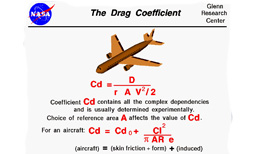 |
| Drag Reduction | Techniques used to minimize aerodynamic resistance. Methods include laminar flow control, winglets, and retractable landing gear. Aircraft designers continuously improve drag reduction strategies to enhance range, fuel economy, and speed while maintaining safety and stability. | 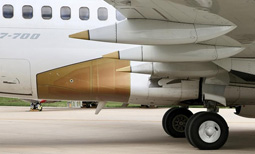 |
| Drain Mast | A small external component used to expel excess fluids such as condensation, fuel residue, or waste from onboard systems. Proper drainage prevents corrosion, icing, and damage to critical components, ensuring aircraft integrity and performance over long-term operation. | 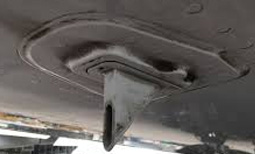 |
| Drift Angle | The angle between an aircraft’s heading and its actual ground track caused by wind. Pilots compensate for drift using wind correction angles to maintain the intended flight path, ensuring accurate navigation, especially when flying cross-country or conducting precision approaches. | 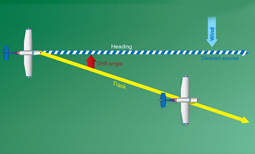 |
| Drift Down | A procedure followed when an engine failure occurs at cruising altitude. The aircraft descends to an altitude where it can maintain level flight on the remaining engine(s). Pilots use drift-down charts to determine optimal altitudes for safety and fuel efficiency. | 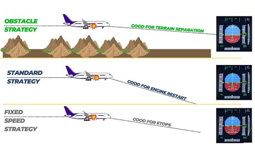 |
| Drop Tank | An external fuel tank mounted on military or long-range aircraft to extend operational range. Drop tanks can be jettisoned in emergencies to reduce weight and improve maneuverability. They play a vital role in ferry flights, combat missions, and long-duration operations. | 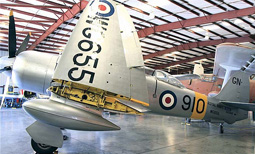 |
| Dry Lease | A leasing arrangement where an aircraft is provided without crew, maintenance, or insurance. The lessee is responsible for all operational aspects. Dry leases are commonly used by airlines expanding their fleets without purchasing new aircraft outright. | 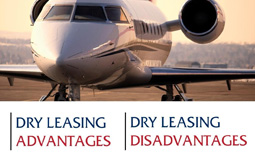 |
| Dutch Roll | A flight instability characterized by coupled yaw and roll oscillations. It is most commonly experienced in swept-wing aircraft. Pilots use yaw dampers to counteract Dutch roll, improving comfort and stability during cruise. | 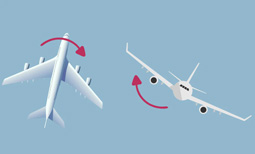 |
| Dynamic Stability | An aircraft’s tendency to return to its original flight condition after a disturbance. It ensures stability over time and helps the aircraft remain controllable in varying flight conditions, minimizing pilot workload and enhancing safety. | 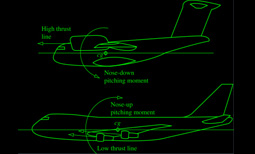 |
